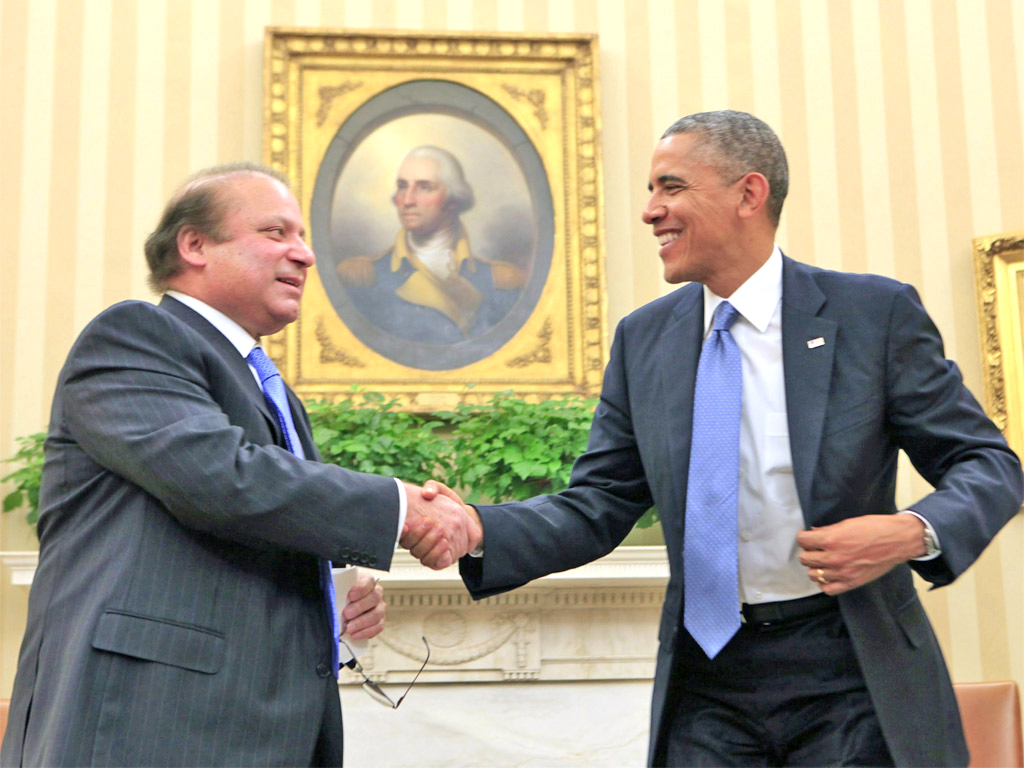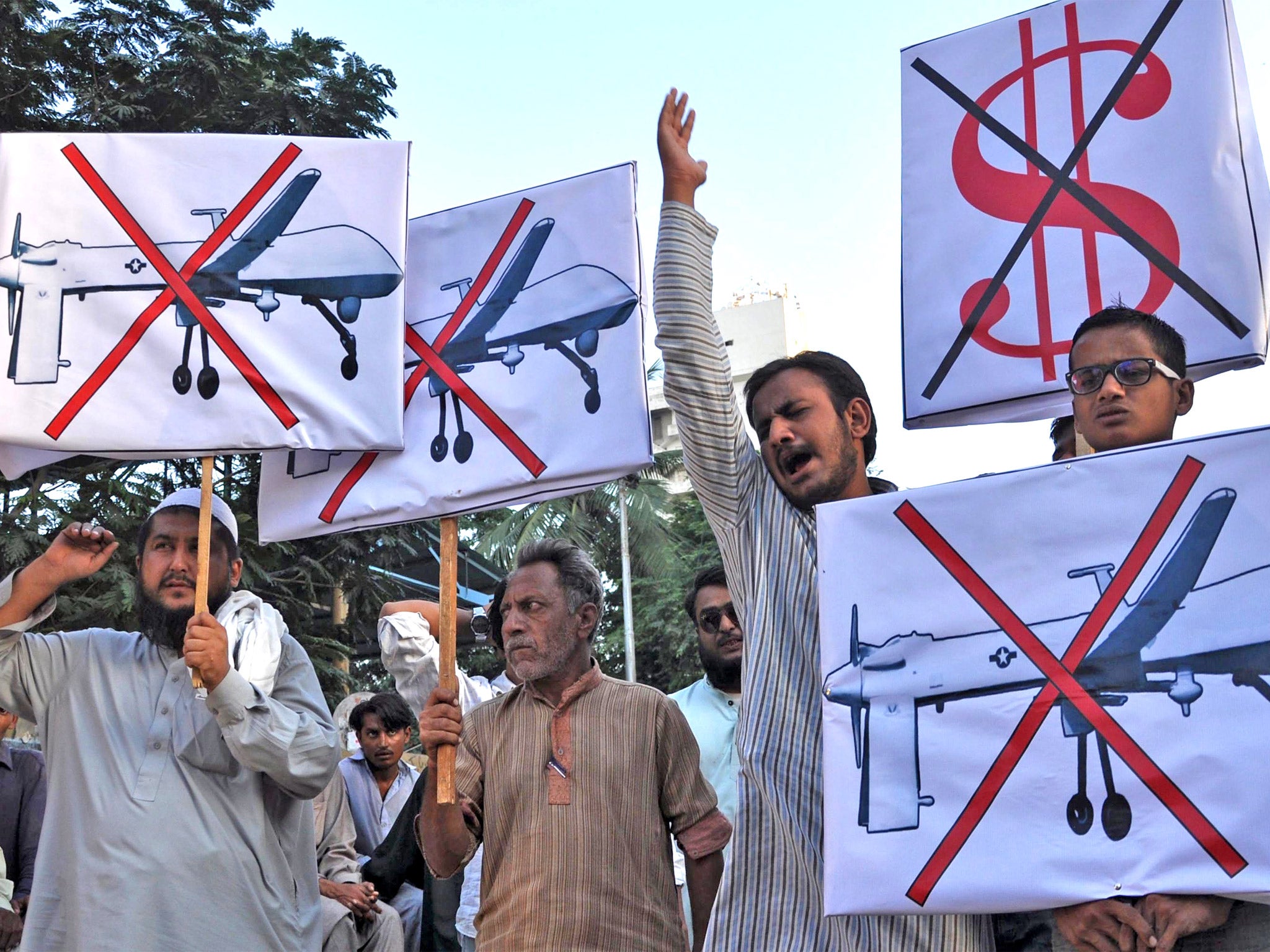Pakistan’s involvement in deadly drone campaign revealed: Government officials played direct role in selecting targets despite repeatedly denouncing the CIA strikes
Top-secret CIA papers show the US briefed Islamabad on attacks against al-Qa’ida targets

Despite repeatedly denouncing the CIA’s drone campaign, top officials in Pakistan’s government have for years secretly endorsed the programme and routinely received classified briefings on strikes and casualty counts, according to top-secret CIA documents and Pakistani diplomatic memos.
The files describe dozens of drone attacks in Pakistan’s tribal region and include maps as well as before-and-after aerial photos of targeted compounds from late 2007 to late 2011, in which the campaign intensified.
Markings on the documents indicate that many of them were prepared by the CIA’s Counterterrorism Centre specifically to be shared with Pakistan’s government. They tout the success of strikes that killed dozens of alleged al-Qa’ida operatives and assert repeatedly that no civilians were harmed.
Pakistan’s tacit approval of the drone programme has been one of the more poorly kept national security secrets in Washington and Islamabad. During the early years of the campaign, the CIA even used Pakistani airstrips for its Predator fleet.
But the files expose the explicit nature of a secret arrangement struck between the two countries at a time when neither was willing to publicly acknowledge the existence of the drone programme. The documents detailed at least 65 strikes in Pakistan. They are marked “top secret” but cleared for release to Pakistan.
A CIA spokesman declined to discuss the documents but did not dispute their authenticity.
Aizaz Ahmad Chaudhry, the spokesman for Pakistan’s foreign ministry, would not comment, but he added that Prime Minister Nawaz Sharif, who took office in June, has been adamant that “the drone strikes must stop”.
Mr Chaudhry said: “We regard such strikes as a violation of our sovereignty as well as international law. They are also counter-productive.”
He said Pakistan’s government is unified against US drone strikes, and has made its disapproval clear to senior US and United Nations officials.

CIA strikes “have deeply disturbed and agitated our people”, Mr Sharif said in a speech on Tuesday at the US Institute of Peace, in Washington. “This issue has become a major irritant in our bilateral relationship as well. I will, therefore, stress the need for an end to drone attacks.” He did not elaborate on how Pakistan would seek to halt a campaign that remains a core part of the Obama administration’s counterterrorism strategy.
There was no immediate comment from Pakistan’s military or intelligence service, but Talat Masood, a retired Pakistani general, said the revelation that Pakistan’s government was well-informed about the drone programme will likely “put cold water on the hype” within Pakistan over the issue. “I think people knew it already, but this makes it much more obvious, and the [Pakistani] media and others will have to cool off,” said Mr Masood.
The files serve as a detailed timeline of the CIA drone programme, tracing its evolution from a campaign aimed at a relatively short list of senior al-Qa’ida operatives into a broader aerial assault against militant groups with no connection to the 9/11 attacks.
The records also expose the distrust and dysfunction that has afflicted US-Pakistani relations even amid collaboration on drone strikes.
Some files describe tense meetings in which senior US officials, including then-Secretary of State Hillary Clinton, confront their Pakistani counterparts with US intelligence purporting to show Pakistan’s ties to militant groups involved in attacks on American forces, a charge that Islamabad has consistently denied.
In one case, Ms Clinton cited “cellphones and written material from dead bodies that point all fingers” at a militant group based in Pakistan, according to a Pakistani diplomatic cable dated 20 September, 2011. “The US had intelligence proving ISI was involved with these groups,” she is cited as saying, referring to Pakistan’s Inter-Services Intelligence agency.
In a measure of the antagonism between the two sides, a 2010 memo sent by Pakistan’s Ministry of Foreign Affairs to its embassy in Washington outlined a plan to undermine the CIA. “Kindly find enclosed a list of 36 US citizens who are [believed] to be CIA special agents and would be visiting Pakistan for some special task,” said the memo, signed by an official listed as the country’s Director General for the Americas. “Kindly do not, repeat not, issue visas to the same.”
The earliest of the files describes 15 strikes from December 2007 to September 2008. All but two of the entries identify specific al-Qa’ida figures as targets. The campaign has since killed as many as 3,000 people, including thousands of militants and hundreds of civilians, according to independent estimates.
There have been 23 strikes in Pakistan this year, far below the peak in 2010, when 117 attacks were recorded. The latest strike occurred on 29 September, when three alleged fighters with ties to the militant Haqqani network were killed in North Waziristan, according to media reports.
Several documents refer to a direct Pakistani role in the selection of targets. A 2010 entry, for example, describes hitting a location “at the request of your government”. Another from that year refers to a “network of locations associated with a joint CIA-ISI targeting effort”.
The documents confirm the deaths of dozens of alleged al-Qa’ida operatives, including Rashid Rauf, a British citizen killed in 2008 who “helped co-ordinate al-Qa’ida’s summer 2007 plot to blow up transatlantic flights originating from Great Britain”, one memo said.
But the documents also reveal a major shift in the CIA’s strategy in Pakistan as it broadened the campaign beyond “high-value” al-Qa’ida targets and began firing missiles at gatherings of low-level fighters.
The files trace the CIA’s embrace of a controversial practice that came to be known as “signature strikes”, approving targets based on patterns of suspicious behaviour detected from drone surveillance and ordering strikes even when the identities of those to be killed weren’t known. At times, the evidence seemed circumstantial.
On 14 January 2010, a gathering of 17 people at a suspected Taliban training camp was struck after the men were observed conducting “assassination training, sparring, push-ups and running”. The compound was linked “by vehicle” to an al-Qa’ida facility hit three years earlier.
Although often uncertain about the identities of its targets, the CIA expresses remarkable confidence in its accuracy, repeatedly ruling out the possibility that any civilians were killed.
Those assertions are at odds with research done by human rights organisations, including Amnesty International, which released a report this week based on investigations of nine drone strikes in Pakistan between May 2012 and July 2013. After interviewing survivors and assembling other evidence, the group concluded that at least 30 civilians had been killed in the attacks.
White House spokesman Jay Carney acknowledged on Tuesday that drone strikes “have resulted in civilian casualties” but defended the programme as highly precise and said there is a “wide gap” between US estimates and those of independent groups.
© The Washington Post
Join our commenting forum
Join thought-provoking conversations, follow other Independent readers and see their replies
Comments